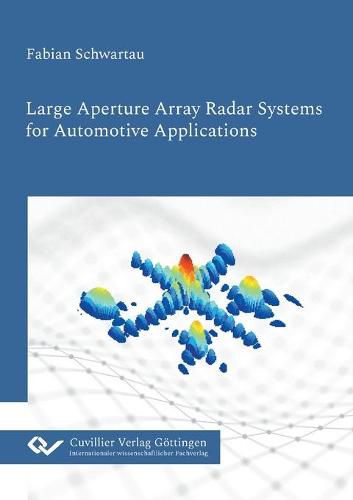Readings Newsletter
Become a Readings Member to make your shopping experience even easier.
Sign in or sign up for free!
You’re not far away from qualifying for FREE standard shipping within Australia
You’ve qualified for FREE standard shipping within Australia
The cart is loading…






This title is printed to order. This book may have been self-published. If so, we cannot guarantee the quality of the content. In the main most books will have gone through the editing process however some may not. We therefore suggest that you be aware of this before ordering this book. If in doubt check either the author or publisher’s details as we are unable to accept any returns unless they are faulty. Please contact us if you have any questions.
The automotive industry is pushing towards highly assisted and even autonomous driving cars. To gather a more precise and reliable representation of the car’s surroundings, the sensors and the signal processing are improving over time and are a subject to continuous research. One essential sensor is the radar, which is robust and reliable even in harsh environmental conditions. The primary downside of a radar is its low resolution compared to lidar or camera-based systems. To mitigate these drawbacks the resolution of radar systems has to be improved. The bandwidth has to be increased to improve the range resolution, and the aperture has to be increased to improve the angular resolution. Primarily caused by the automotive industry, fully integrated radar on chip solutions are now available and allow the construction of more complex radar systems. These radar on chip devices lay the foundation for radars that fulfill the requirements of increased resolution for future systems. Although this work is focused automotive applications, most ideas, concepts, and calculations are also applicable to other fields. Similar systems may be used in the security sector, quality control in industrial processes, or gesture detection, to name a few examples. This thesis shows the development of a conceptual future radar system for automotive applications. The focus is on providing a large antenna aperture to achieve the required high angular resolution. Two genetic algorithms are developed to optimize the antenna array for a good side lobe level while providing high angular resolution. Two demonstrators are built to implement certain aspects of the proposed radar system and prove the general concept viable. The first demonstrator features a large aperture with a limited side lobe level and is using a modular approach. The modules are synchronized with a radio over fiber system. The second demonstrator uses the previously proposed antenna array, which is implemented with a synthetic a
$9.00 standard shipping within Australia
FREE standard shipping within Australia for orders over $100.00
Express & International shipping calculated at checkout
This title is printed to order. This book may have been self-published. If so, we cannot guarantee the quality of the content. In the main most books will have gone through the editing process however some may not. We therefore suggest that you be aware of this before ordering this book. If in doubt check either the author or publisher’s details as we are unable to accept any returns unless they are faulty. Please contact us if you have any questions.
The automotive industry is pushing towards highly assisted and even autonomous driving cars. To gather a more precise and reliable representation of the car’s surroundings, the sensors and the signal processing are improving over time and are a subject to continuous research. One essential sensor is the radar, which is robust and reliable even in harsh environmental conditions. The primary downside of a radar is its low resolution compared to lidar or camera-based systems. To mitigate these drawbacks the resolution of radar systems has to be improved. The bandwidth has to be increased to improve the range resolution, and the aperture has to be increased to improve the angular resolution. Primarily caused by the automotive industry, fully integrated radar on chip solutions are now available and allow the construction of more complex radar systems. These radar on chip devices lay the foundation for radars that fulfill the requirements of increased resolution for future systems. Although this work is focused automotive applications, most ideas, concepts, and calculations are also applicable to other fields. Similar systems may be used in the security sector, quality control in industrial processes, or gesture detection, to name a few examples. This thesis shows the development of a conceptual future radar system for automotive applications. The focus is on providing a large antenna aperture to achieve the required high angular resolution. Two genetic algorithms are developed to optimize the antenna array for a good side lobe level while providing high angular resolution. Two demonstrators are built to implement certain aspects of the proposed radar system and prove the general concept viable. The first demonstrator features a large aperture with a limited side lobe level and is using a modular approach. The modules are synchronized with a radio over fiber system. The second demonstrator uses the previously proposed antenna array, which is implemented with a synthetic a